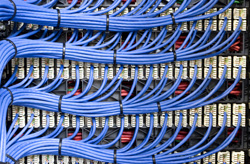Types of Data Cabling
Introduction
 The choice of network cabling is one of the most important ones during your enterprise network installation. Different forms of cabling have different capabilities and are best suited to specific tasks. While it is possible to combine several types of cabling to provide targeted benefits throughout your network, it is typically a good idea to use your cabling with a single brand of network interface hardware — this makes it easier to maintain and update your network as your needs evolve.
The choice of network cabling is one of the most important ones during your enterprise network installation. Different forms of cabling have different capabilities and are best suited to specific tasks. While it is possible to combine several types of cabling to provide targeted benefits throughout your network, it is typically a good idea to use your cabling with a single brand of network interface hardware — this makes it easier to maintain and update your network as your needs evolve.
Our company will help you select the right kind of cabling and make plans so you can easily expand your network in the future. When thinking about which type of data cabling to use, keep in mind the information on pros, cons and other considerations provided below. Naturally, every network is unique and yours will receive personal attention from our experts; if you have any questions, feel free to contact us any time for further details.
Cat5E
Cat5E is a standard data cabling solution that has been replacing traditional Cat5 cabling as the “go to” cabling type for most data runs. Cat5E is capable of operating at speeds of a gigabit without complication and is suitable for a very wide variety of business applications. It is also extremely cost-effective and very familiar to any network technician, so it can be replaced easily in the event of damage or other problems. However, it is not suitable for specialized applications or high speed transmissions.
Physically, Cat5E is relatively flimsy compared to Cat 6. It is also more prone to damage through twisting and bending than Cat 6 is — such damage frequently requires the complete replacement of a span of cable. Likewise, Cat5E is more susceptible to signal degradation caused by electrical devices and industrial equipment that might be located near it. To use Cat5E effectively, you will need to use a repeater to enhance signal strength every 330 feet. A maximum of two repeaters can typically be used before signal degradation becomes prohibitive.
Cat 6
Cat 6 is an enhanced type of copper twisted pair data cabling, similar in design to Cat5E. Because it can handle higher frequencies than its Cat5E cousin and offers superior quality of transmission, a network using Cat 6 will typically run faster and more efficiently than one using Cat5E. In any given transmission, less data will be lost and retransmitted, saving time and money. Likewise, Cat 6 is less vulnerable to outside interface due to its superior shielding, which makes it thicker and more durable than Cat5E.
Although Cat 6 is more durable and transmits faster than Cat5E, it is not usually used for networks that require standard data transmission rates well in excess of what Cat5E delivers. It is considerably more expensive to manufacture, purchase or replace than is Cat5E, partially because of its increased thickness. That thickness also means that it must be laid more carefully; network planners should be careful of narrow bends that can cause cable damage. A repeater is required for every ~300 feet of standard Cat 6 cable.
Giga Cat 6a
Giga Cat 6a is an improved standard of copper cabling that supports transmission speeds of up to ten gigabits. This is a revolutionary development in copper cabling; for many years it was widely believed that physical limitations made it impossible to enhance copper-based cabling beyond the original Cat 6 standard. Cat 6a comes in shielded and unshielded varieties, both of which are excellent at suppressing interference. Like its predecessors, Cat 6a is easy to install. It provides superlative speeds over short distances.
Although Cat 6a is effective to a maximum speed of ten gigabits, it is not able to maintain this speed beyond a short distance — 180 feet is generally agreed as the maximum Cat 6a run that still exhibits top signal quality. Effective network design can ameliorate the interference between adjacent connections and hardware that tends to limit the length of Cat 6a runs. However, if a network will require several very long cable runs at a high speed, it is a good idea to consider 10 Gigabit Ethernet instead of Giga Cat 6a.
10 Gigabit
10 Gigabit Ethernet refers to a variety of interrelated standards that are especially designed to deliver standard transmission rates of ten gigabits. It is an extremely fast standard and will help networks support exceptional speeds even with heavy enterprise usage. Although cost will always be a factor in such an installation, 10 Gigabit Ethernet is frequently used as an alternative to more expensive and fragile fiber optic solutions.
That said, 10 Gigabit Ethernet can be costly. When there is a widespread need for 10 Gigabit cabling throughout a network, it may be time to start planning for the next evolution of the network using fiber optic or broadband wireless.



